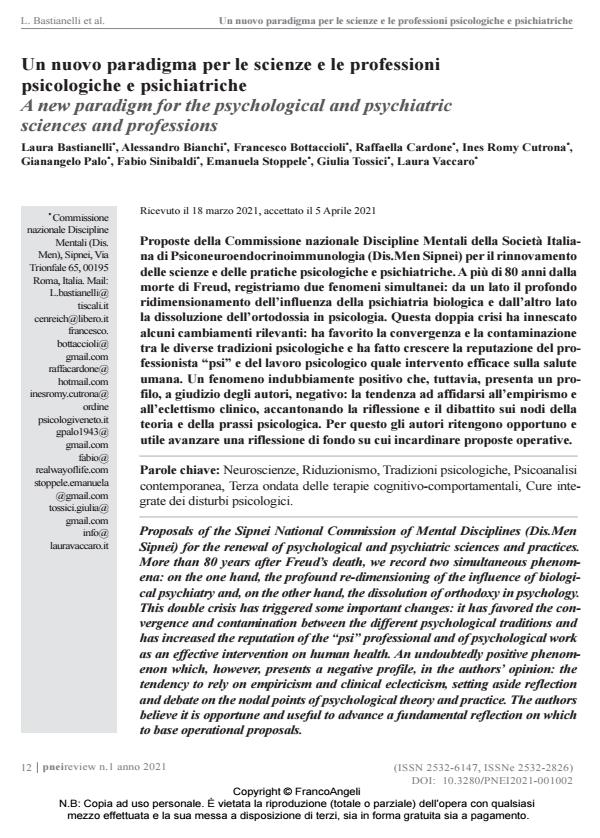A new paradigm for the psychological and psychiatric sciences and professions
Journal title PNEI REVIEW
Author/s Laura Bastianelli, Alessandro Bianchi, Francesco Bottaccioli, Raffaella Cardone, Ines Romy Cutrona, Gianangelo Palo, Fabio Sinibaldi, Emanuela Stoppele, Giulia Tossici, Laura Vaccaro
Publishing Year 2021 Issue 2021/1
Language Italian Pages 58 P. 12-69 File size 1533 KB
DOI 10.3280/PNEI2021-001002
DOI is like a bar code for intellectual property: to have more infomation
click here

FrancoAngeli is member of Publishers International Linking Association, Inc (PILA), a not-for-profit association which run the CrossRef service enabling links to and from online scholarly content.
Proposals of the Sipnei National Commission of Mental Disciplines (Dis.Men Sipnei) for the renewal of psychological and psychiatric sciences and practices. More than 80 years after Freud’s death, we record two simultaneous phenomena: on the one hand, the profound re-dimensioning of the influence of biological psychiatry and, on the other hand, the dissolution of orthodoxy in psychology. This double crisis has triggered some important changes: it has favored the convergence and contamination between the different psychological traditions and has increased the reputation of the "psi" professional and of psychological work as an effective intervention on human health. An undoubtedly positive phenomenon which, however, presents a negative profile, in the authors’ opinion: the tendency to rely on empiricism and clinical eclecticism, setting aside reflection and debate on the nodal points of psychological theory and practice. The authors believe it is opportune and useful to advance a fundamental reflection on which to base operational proposals.
Keywords: Neurosciences, Reductionism, Psychological schools, Contemporary psychoanalysis, Third wave of behavioral and cognitive therapies, Integrated care of mental disorders.
- The Role of Affectivity in Pre-Reflective Experience. The Contributions of Neuroscientific, Psychoanalytical and Developmental Perspectives Giulia Tossici, Valentino Zurloni, Giuseppina Marsico, Raffaele De Luca Picione, in Human Arenas /2024
DOI: 10.1007/s42087-024-00429-y - Come gli stati psichici si traducono in molecole biologiche e come questo cambia la medicina e la psicologia Anna Giulia Bottaccioli, Francesco Bottaccioli, in PSICOTERAPIA E SCIENZE UMANE 1/2023 pp.107
DOI: 10.3280/PU2023-001012
Laura Bastianelli, Alessandro Bianchi, Francesco Bottaccioli, Raffaella Cardone, Ines Romy Cutrona, Gianangelo Palo, Fabio Sinibaldi, Emanuela Stoppele, Giulia Tossici, Laura Vaccaro, Un nuovo paradigma per le scienze e le professioni psicologiche e psichiatriche in "PNEI REVIEW" 1/2021, pp 12-69, DOI: 10.3280/PNEI2021-001002